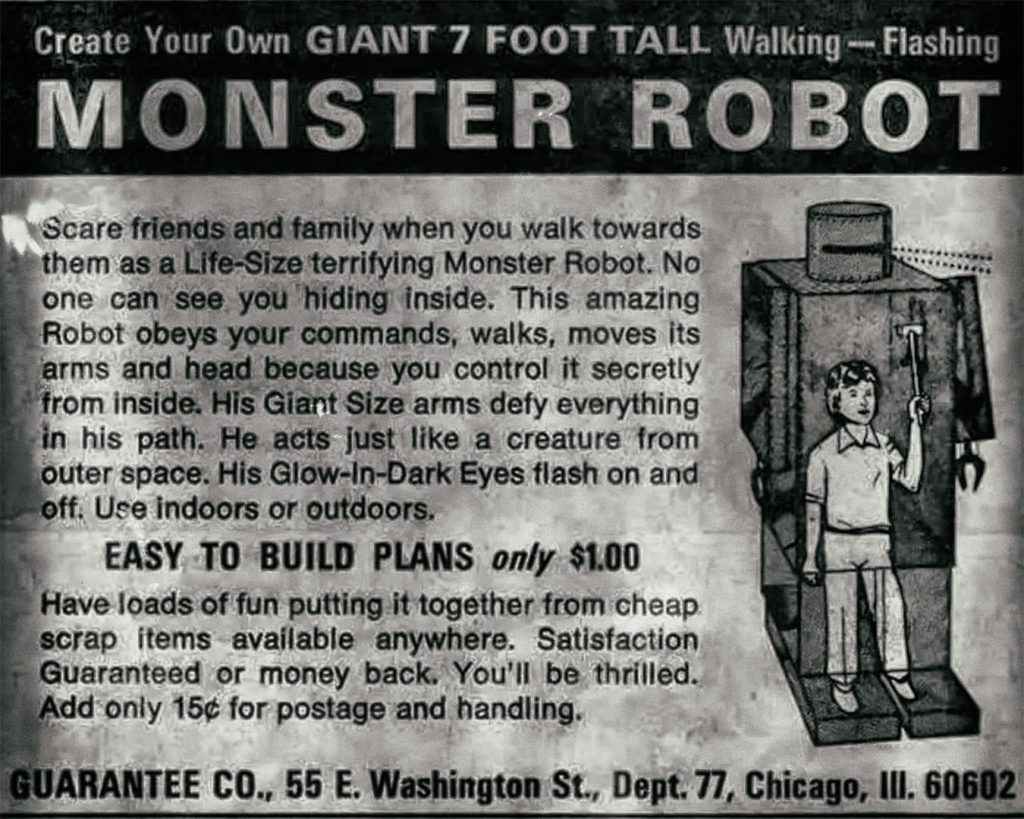No i znowu wpadłem w internetową dziurę bez dna. Wiecie, jak to jest. Zaczęło się od przeglądania archiwów amerykańskich komiksów i magazynów z lat 50. i 60. W pewnym momencie zawiesiłem się na reklamach z ostatniej strony jednego z magazynów. Obiecywała istne cuda za dolara.

The giant 7 foot tall walking-flashing monster robot!
Spójrz na tę grafikę. Groźna! Ma błyskające oczy! Za jednego dolara ten technologiczny cud mógł być Twój. Niezła okazja, prawda?
Oczywiście rzeczywistość była znacznie bardziej skromna. Po wysłaniu ciężko zarobionego dolara — co dla dziecka wtedy było niemałą kwotą — nie dostawało się skrzyni pełnej stali i elektroniki. Przychodziły plany, jak zbudować robota z kartonu, drutu i żarówek z latarki. To była lekcja życia — do samodzielnego montażu! Magia nie tkwiła w produkcie, tylko w obietnicy — w szansie, by poczuć się jak szalony naukowiec we własnym garażu.
Dlaczego te reklamy były wszędzie? To proste — korzystały z fali szału na science fiction. Lata 50. i 60. były przesycone filmami o gigantycznych robotach i kosmicznych potworach z promieniami śmierci. Te reklamy trafiały prosto w tę fantazję. Nie sprzedawały robota. Sprzedawały marzenie!
Spędziłem sporo czasu, próbując znaleźć pełne, oryginalne instrukcje do tego konkretnego modelu. Jakie to byłoby fantastyczne — zbudować ten kawałek nostalgii! Niestety, kompletne plany najwyraźniej przepadły w odmętach czasu.
Ale moje poszukiwania doprowadziły mnie do czegoś innego. Prawdziwego skarbu!
“TRAGEDY ON WASHINGTON AVE”
The Greeneville Post, Oct. 20, 1974
A 12 year old boy is dead, shot to death by police, and the grieving parents can only wonder how this tragedy could have been averted.
On Sunday afternoon, as the autumn leaves blew down the street of this average suburb, what started out as a young boy’s craft project ended up with a terrified neighborhood, stunned police, and a bereaved family mourning for a budding scientist cut down in his youth.
At 6:18 PM on the eve of the 19th, the Greeneville Police Department received a panicked call from Mrs. Crinklecut, the elderly retired schoolmarm beloved by the whole town. Her frantic report of a “monstrous, horrifying mechanical man” terrorizing her and her dog were at first met with disbelief by the dispatcher. But the patrol car sent to calm her down soon reported back a confirmation of the description.
With a request for backup, Lt. Spooner’s radio call described a “hulking metal creature” on the rampage down the street. It stood seven feet tall, with “flashing, glowing eyes,” with giant-sized arms that defied everything in its path. “It acts just like a creature from outer space” he radioed in, and as soon as the other cars arrived the police surrounded the mysterious being and demanded that it surrender.
Ignoring the commands crackling over the loudspeaker, the menacing metal monster slowly raised its left arm threateningly toward the armed authorities. The command to fire was given in response, and when the smoke cleared the thing lay on its side, blood leaking from holes left in the silver body by the policemen’s bullets.
It was with shock and horror that they then discovered that inside the thing was the body of a boy. Identified by a neighborhood friend as Bobby Theakson, the saddened police realized that the “alien creature” had only been a suit made of spray-painted paneling wood and cheap scrap items available anywhere. The inventive young man had apparently tinkered it together in his garage, over the course of several weeks each day after school. He had been controlling it from the inside, via an ingenious series of levers. Plans for building the incredible machine were found in the garage, and were seized by the authorities to be turned over to the F.B.I. for investigation.
Wiping his eyes, Lt. Spooner bemoaned, “I’m sorry that this turned out so badly. When it raised its arm, we could only assume it was about to fire some kind of ray-beam that would turn us all into skeletons.”
The tearful parents did not blame the brave police as the ambulance took away the body of the boy. “We never dreamed he was building such a dangerous weapon,” sobbed his mother, Helen. “We thought it was a doghouse.” “He was too smart for his own good,” agreed the father, Bill Theakson, as he held his wife close. “Always reading those comic books. We knew it would get him into trouble one day.” Motioning for Bobby’s younger brother, he drew him near. “At least we still have Randy, who is on the PeeWee football team, which is more normal and safe.”
The machine that caused the horror was burned by the neighbors on a curbside leaf pile, as they gathered that evening to console one another and try to purge the fear that for one brief fall afternoon gripped this quiet town. But few will be able to forget the nightmare that stalked the street with blinking, glowing eyes.
To klasyczny przykład fikcji, doskonale naśladujący styl lokalnej gazety. Struktura to typowy hoax — fałszywa wycinka prasowa. Dlaczego powstała? Bo coś, co wygląda jak prawdziwa gazeta, automatycznie budzi zaufanie. Nadaje autorytet i pozory faktu czemuś, co jest całkowitą fikcją.
W latach 70., 80. i 90. był to popularny zabieg wśród fanów sci-fi, na wczesnych forach i w łańcuszkach mailowych. Dostawałeś maila z tytułem — Szokująca historia! — i w środku był ten tekst, podany jako dziwne znalezisko z lokalnej gazety. Idealny format na wirusowy hit sprzed epoki social mediów.
Brzmi znajomo? Dziś nazwalibyśmy to fake newsem i wrzucili na Facebooka, ostrzegając znajomych. Technologia się zmieniła, ale sedno pozostało — potrzeba dzielenia się szokującą, emocjonalną historią. Nadal przesyłamy te same łańcuszki, tylko w nowym opakowaniu.
Zabawne, że tani, kartonowy robot z komiksu z lat 50. mógł dekady później zainspirować historię, która tak trafnie pokazuje, jak bardzo kochamy dać się porwać dobrej, strasznej opowieści. Ten potwór nie wyszedł tylko z garażu. Wyszedł prosto z naszej zbiorowej wyobraźni!
